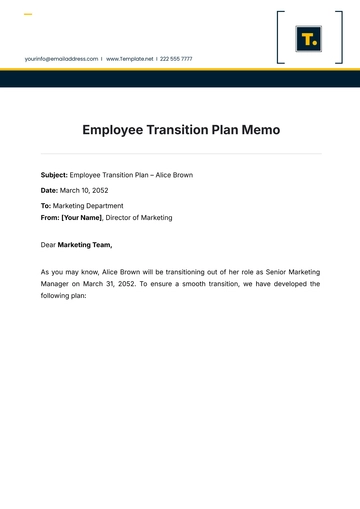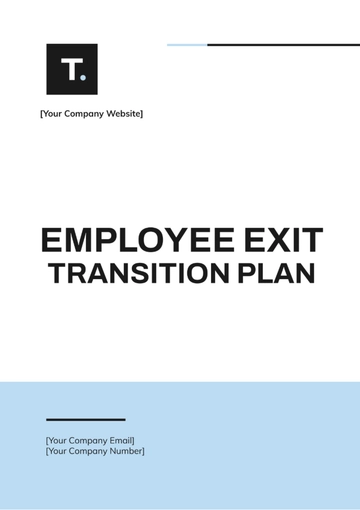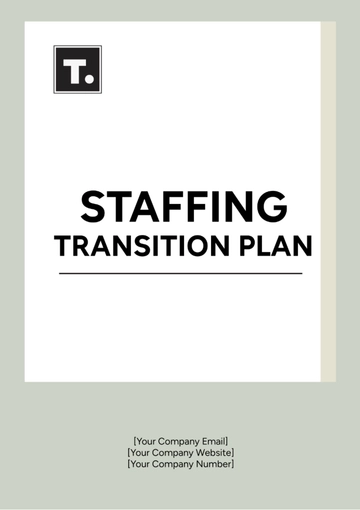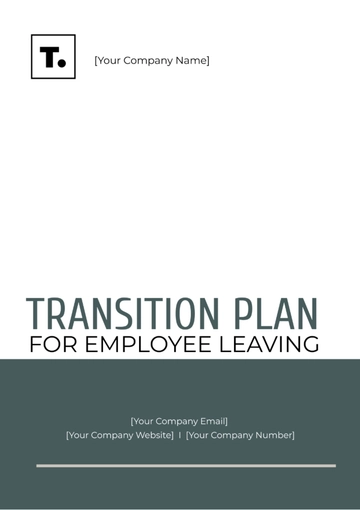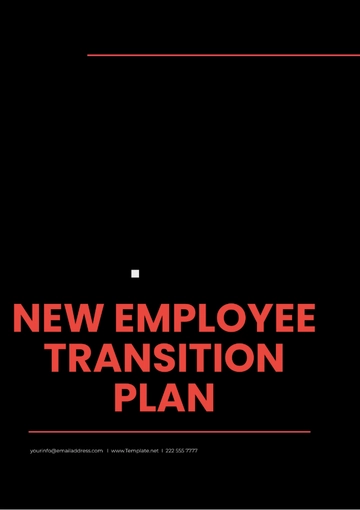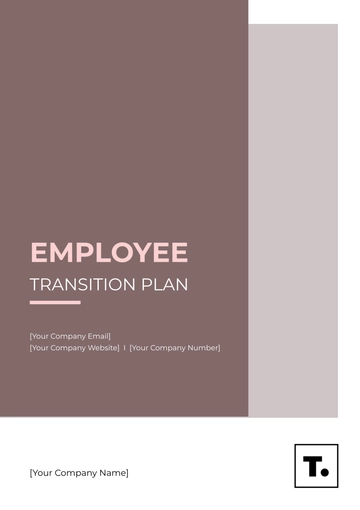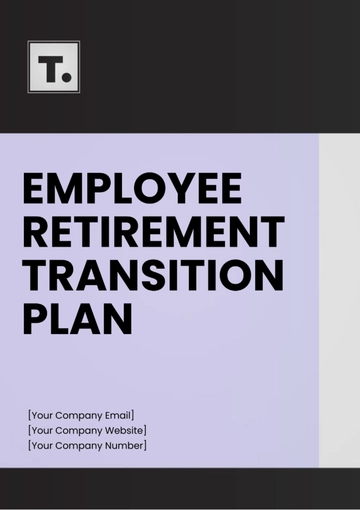Free Legal Employment & Labor Workforce Diversity Plan
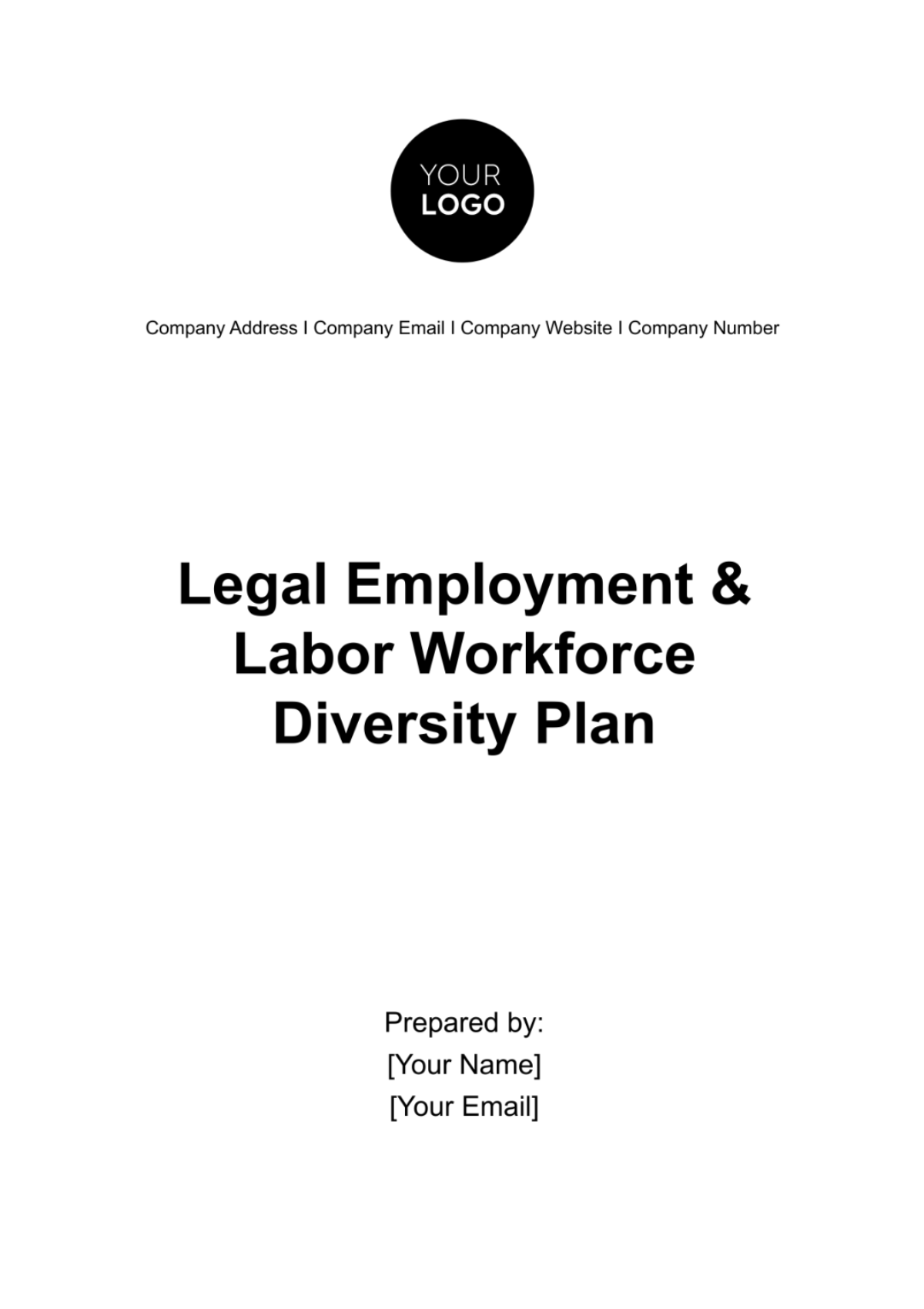
I. Introduction
A. Importance
Workforce diversity is a critical component of a successful business strategy for our company. It is about more than just acknowledging differences in people. It involves recognizing the value of diversity, combating discrimination, and promoting inclusiveness.
Innovation: Diverse teams bring together a variety of perspectives, ideas, and experiences, fostering creativity and innovation. By having a diverse workforce, we can tap into a wealth of ideas that can lead to innovative solutions and strategies.
Representation: A diverse workforce can better represent a diverse customer base, understanding their needs and perspectives more effectively. This can lead to improved customer satisfaction and loyalty.
Talent Attraction: Companies that are committed to diversity attract a wider range of candidates. This can lead to a more skilled and talented workforce, which can give us a competitive advantage in the market.
Employee Satisfaction: A diverse and inclusive workplace tends to have higher employee satisfaction and lower turnover rates. This can lead to improved productivity and a more positive work environment.
B. Scope
This plan outlines [Your Company Name]'s commitment to creating a diverse and inclusive workplace. It provides a roadmap for how we will recruit, retain, and develop a diverse workforce at all levels of our organization.
Recruitment: We will strive to attract a diverse pool of candidates for all positions. This includes reaching out to underrepresented groups and ensuring our job postings are inclusive and welcoming.
Retention: We will create an inclusive work environment where all employees feel valued and respected, regardless of their differences. This includes implementing policies and practices that promote inclusivity and diversity.
Development: We will provide opportunities for all employees to learn, grow, and advance within our organization. This includes providing training and development opportunities that are accessible and beneficial to all employees.
Accountability: We will hold ourselves accountable for achieving the goals outlined in this plan. This includes regularly reviewing and updating our diversity goals and strategies, and ensuring all employees are aware of and committed to these goals.
By following this plan, we aim to create an enriched environment that champions equality, fosters innovation, and reflects the diversity of the communities we serve. This will not only enhance our organizational culture but also drive our business success.
II. Objective
The objective of this plan is to foster an inclusive and diverse workforce within our organization. This involves a commitment to recruiting and retaining individuals from various backgrounds, experiences, and perspectives which are specified below:
A. Race
Our organization strives to create a racially diverse environment that respects and values the unique experiences and perspectives that individuals of different races bring to our organization. We understand that racial diversity enriches our collective perspective and enhances our ability to adapt to an increasingly multicultural world.
B. Gender
We are committed to achieving gender balance at all levels within our organization. We recognize the equal and significant contributions made by both men and women. We believe that gender diversity is essential for fostering a balanced perspective and promoting a culture of equality and respect.
C. Age
We value the multi-generational workforce and believe that employees of all ages bring valuable experiences and insights. We understand that age diversity can foster a dynamic work environment where wisdom, innovation, and fresh perspectives can thrive.
D. Nationality
We appreciate the cultural richness that employees of different nationalities bring to our organization. We believe that nationality diversity can enhance our understanding of different cultures and global markets, thereby improving our competitiveness in the global marketplace.
E. Sexual Orientation
We are committed to creating an inclusive environment where employees of all sexual orientations feel safe, valued, and respected. We understand that diversity in sexual orientation can foster a more inclusive and accepting workplace environment.
F. Physical Abilities
We believe in providing equal opportunities to individuals with different physical abilities. We are committed to making our workplace accessible to all and understand that diversity in physical abilities can foster a more inclusive and empathetic workplace environment.
III. Recruitment Strategies
To ensure diversity in our company, varied recruitment practices will be thoroughly integrated. The following table outlines our key recruitment strategies:
Strategy | Description |
|---|---|
Diverse Recruitment Platforms | Utilize a variety of job boards and platforms that cater to diverse audiences. |
The use of a variety of job boards and platforms aims to cater to diverse audiences. This strategy is crucial as it allows us to reach a wider pool of potential candidates, thereby increasing the likelihood of attracting a diverse set of applicants. By utilizing diverse recruitment platforms, we can ensure that our job postings reach individuals from various backgrounds, experiences, and perspectives. This not only increases the diversity of our applicant pool but also enhances the richness of ideas, skills, and experiences within our company.
In today’s globalized world, it is crucial us to reflect on the diversity of the communities we serve. By attracting a diverse set of applicants, we can foster a more inclusive and innovative workplace, drive business success, and enhance our reputation as an employer of choice. Each of these strategies plays a crucial role in attracting, selecting, and retaining a diverse workforce. By implementing these strategies, we are taking a significant step towards creating a more inclusive and diverse workplace.
IV. Retention Strategies
Retention initiatives are crucial for maintaining a diverse and inclusive workplace. These strategies focus on creating an environment where all employees feel valued and respected, which in turn encourages them to stay with the organization. The following table outlines our retention strategies:
Strategy | Description |
|---|---|
Equal Opportunities | Ensure equal promotional opportunities for all employees, regardless of their background. |
Each of these strategies plays a crucial role in creating an environment where all employees feel valued and respected. By implementing these strategies, we are taking a significant step towards creating a more inclusive and diverse workplace.
Equal Opportunities showcases our commitment to ensuring equal promotional opportunities for all employees, regardless of their background. This strategy is crucial as it fosters a sense of fairness and inclusivity within the organization. This includes promotions, training, and career development opportunities. By ensuring equal opportunities, we can create a work environment where all employees feel valued and respected, which can lead to improved job satisfaction and employee retention.
The importance of equal opportunities cannot be overstated. It not only fosters a sense of fairness and inclusivity but also contributes to a more diverse and innovative workforce. By ensuring that all employees have the same access to opportunities and resources, we can leverage the full potential of our workforce and drive business success.
V. Compliance with Laws and Regulations
Our diversity plan will be in compliance with all relevant employment laws and regulations. This includes adhering to any local and state regulations concerning employment and diversity.
A. Federal Laws
Equal Employment Opportunity Commission (EEOC) Guidelines: We are committed to adhering to the guidelines set forth by the EEOC, which prohibit discrimination in employment based on race, color, religion, sex, national origin, age, disability, or genetic information. These guidelines are crucial in ensuring a fair and equitable workplace for all employees.
1.1. Prohibit discrimination in hiring, promotion, job assignment, termination, and compensation.
1.2. Protect employees from harassment based on their protected characteristics.
1.3. Require employers to provide reasonable accommodations to qualified individuals with disabilities.
American Disabilities Act (ADA): We are committed to complying with the ADA, which prohibits discrimination against individuals with disabilities and requires employers to provide reasonable accommodations. This act ensures that individuals with disabilities have equal opportunities in the workplace.
2.1. Prohibit discrimination against qualified individuals with disabilities in all aspects of employment.
2.2. Require employers to provide reasonable accommodations to qualified individuals with disabilities, unless doing so would cause significant difficulty or expense for the employer.
2.3. Prohibit retaliation against individuals who enforce their rights under the ADA.
Title VII of the Civil Rights Act of 1964: We are committed to adhering to Title VII, which prohibits employment discrimination based on race, color, religion, sex, and national origin. This act is a cornerstone of equal employment opportunity and protects employees from discriminatory practices.
3.1. Prohibit from discriminating against individuals because of their race, color, national origin, sex, or religion.
3.2. Apply to all terms, conditions, and privileges of employment, including hiring, firing, promotion, compensation, job training, and more.
3.3. Prohibit both intentional discrimination and neutral job policies that disproportionately exclude minorities and that are not job related.
B. State Laws
State Anti-Discrimination Laws: We will comply with all state laws that prohibit employment discrimination based on factors such as race, color, religion, sex, national origin, age, disability, or genetic information. These laws play a crucial role in ensuring a fair and equitable workplace at the state level.
1.1. Prohibit discrimination in hiring, promotion, job assignment, termination, and compensation.
1.2. Protect employees from harassment based on their protected characteristics.
1.3. Require employers to provide reasonable accommodations to qualified individuals with disabilities.
State Equal Pay Laws: We are committed to adhering to state laws that require equal pay for equal work, regardless of an employee’s gender. These laws ensure that all employees are compensated fairly for their work.
2.1. Require to provide equal pay for equal work performed in the same establishment.
2.2. Prohibit wage discrimination on the basis of sex.
2.3. Allow employees to disclose and discuss their wages.
State Disability Laws: We will comply with state laws that provide protections for individuals with disabilities, including requirements for reasonable accommodations. These laws ensure that individuals with disabilities have equal opportunities in the workplace.
3.1. Prohibit discrimination against qualified individuals with disabilities in all aspects of employment.
3.2. Require employers to provide reasonable accommodations to qualified individuals with disabilities, unless doing so would cause significant difficulty or expense for the employer.
3.3. Prohibit retaliation against individuals who enforce their rights under the state disability laws.
State Age Discrimination Laws: We are committed to adhering to state laws that prohibit age discrimination in employment. These laws protect individuals of all ages from discriminatory practices in the workplace.
4.1. Prohibit discrimination in hiring, promotion, job assignment, termination, and compensation based on age.
4.2. Protect employees from harassment based on their age.
4.3. Prohibit retaliation against individuals who enforce their rights under the state age discrimination laws.
State Sexual Orientation and Gender Identity Laws: We will comply with state laws that prohibit discrimination based on sexual orientation and gender identity. These laws ensure that all individuals, regardless of their sexual orientation or gender identity, have equal opportunities in the workplace.
5.1. Prohibit discrimination in hiring, promotion, job assignment, termination, and compensation based on sexual orientation and gender identity.
5.2. Protect employees from harassment based on their sexual orientation and gender identity.
5.3. Prohibit retaliation against individuals who enforce their rights under the state sexual orientation and gender identity laws.
C. Local Regulations
Local Anti-Discrimination Ordinances: We will comply with any local ordinances that prohibit employment discrimination based on factors such as race, color, religion, sex, national origin, age, disability, or genetic information. These ordinances play a crucial role in ensuring a fair and equitable workplace at the local level.
Local Equal Pay Ordinances: We are committed to adhering to local ordinances that require equal pay for equal work, regardless of an employee’s gender. These ordinances ensure that all employees are compensated fairly for their work.
Local Disability Ordinances: We will comply with local ordinances that provide protections for individuals with disabilities, including requirements for reasonable accommodations. These ordinances ensure that individuals with disabilities have equal opportunities in the workplace.
Local Age Discrimination Ordinances: We are committed to adhering to local ordinances that prohibit age discrimination in employment. These ordinances protect individuals of all ages from discriminatory practices in the workplace.
By adhering to these laws and regulations, we ensure that our diversity initiatives are not only effective but also lawful. This commitment to compliance underscores our dedication to creating a diverse and inclusive workplace where all employees are treated with fairness and respect.
VI. Monitoring and Evaluation
[Your Company Name] will use a system for monitoring and evaluating the success of the diversity initiatives will be implemented. Key performance metrics will be determined and regularly reviewed to measure the success of the diversity plan. The following table outlines the key performance metrics that we will use to evaluate the success of our diversity initiatives:
Metrics | Baseline | Target |
|---|---|---|
Employee satisfaction scores from underrepresented groups | 70% | 85% |
Each metric provides a unique perspective on our diversity outcomes, allowing us to assess our progress from multiple angles. By tracking a variety of metrics, we can gain a comprehensive understanding of our diversity outcomes and ensure that we are making progress towards all of our diversity goals. This comprehensive approach to monitoring and evaluation is crucial for the success of our diversity plan.
Employee satisfaction scores from underrepresented groups”, represents one of the key performance indicators that we will use to measure the success of our diversity initiatives. This metric provides a quantifiable measure of how satisfied our employees from underrepresented groups are within our organization.
The baseline value of 70% indicates the current satisfaction level of employees from underrepresented groups. The target value of 85% is the desired satisfaction level we aim to achieve through our diversity initiatives. Understanding our baseline, which is our starting point, and setting a clear target for improvement, allows us to measure our progress in a tangible way. It enables us to identify areas where we are making progress and areas where we need to focus more effort.
The importance of monitoring and evaluation in any diversity plan cannot be overstated. Regular monitoring allows us to identify any issues or challenges early and to make necessary adjustments. Evaluation allows us to assess the overall effectiveness of our diversity initiatives and to make evidence-based decisions about future strategies.
VII. Communication Strategy
Effective communication is a critical component of our diversity plan. It ensures that all employees are aware of our diversity goals, understand their role in achieving these goals, and feel valued and included in our diversity initiatives.
A. Internal Communication
Awareness Campaigns: We will conduct awareness campaigns to educate employees about the importance of diversity and inclusion. These campaigns will highlight the benefits of a diverse workforce and promote our commitment to creating an inclusive workplace.
1.1. Regular updates: We will provide regular updates on our diversity initiatives and progress towards our diversity goals.
1.2. Training sessions: We will conduct training sessions to educate employees about diversity and inclusion, and to equip them with the skills to foster an inclusive workplace.
1.3. Employee resource groups: We will support the formation of employee resource groups that provide a supportive community for employees from underrepresented groups.
Feedback Mechanisms: We will establish mechanisms for employees to provide feedback on our diversity initiatives. This feedback will be invaluable in identifying areas for improvement and ensuring that our initiatives are effective and inclusive.
2.1. Surveys: We will conduct regular surveys to gather employee feedback on our diversity initiatives.
2.2. Open forums: We will hold open forums where employees can share their experiences and suggestions related to diversity and inclusion.
2.3. Suggestion boxes: We will provide suggestion boxes where employees can anonymously submit their feedback and suggestions.
Recognition Programs: We will implement recognition programs to acknowledge and celebrate the contributions of employees towards our diversity goals. These programs will foster a sense of belonging and appreciation among our employees.
3.1. Awards: We will present awards to employees who have made significant contributions to our diversity initiatives.
3.2. Spotlights: We will spotlight employees who have demonstrated a commitment to promoting diversity and inclusion in our internal communications.
3.3. Celebrations: We will celebrate diversity-related milestones and events to foster a sense of community and inclusion among our employees.
B. External Communication
Public Commitment: We will publicly communicate our commitment to diversity and inclusion. This will not only enhance our reputation as an inclusive employer but also attract a diverse pool of candidates.
1.1. Website: We will highlight our commitment to diversity and inclusion on our website.
1.2. Social media: We will use social media platforms to share updates on our diversity initiatives and to engage with a diverse audience.
1.3. Press releases: We will issue press releases to announce significant diversity-related achievements and initiatives.
Partnerships: We will establish partnerships with external organizations that promote diversity and inclusion. These partnerships will enhance our diversity initiatives and provide us with valuable resources and insights.
2.1. Non-profit organizations: We will partner with non-profit organizations that advocate for underrepresented groups.
2.2. Educational institutions: We will collaborate with educational institutions to attract a diverse pool of candidates.
2.3. Industry groups: We will join industry groups that are committed to promoting diversity and inclusion in our industry.
Transparency: We will be transparent about our diversity goals and progress. This transparency will enhance our credibility and accountability.
3.1. Annual reports: We will include a section on diversity and inclusion in our annual reports, detailing our goals, initiatives, and progress.
3.2. Public forums: We will participate in public forums where we can discuss our diversity initiatives and learn from others.
3.3. Stakeholder meetings: We will discuss our diversity goals and progress in meetings with stakeholders, including investors, customers, and community leaders.
By implementing this communication strategy, we can ensure that all employees are aware of and committed to our diversity goals, and that our commitment to diversity and inclusion is communicated to our external stakeholders. This will not only enhance our organizational culture but also drive our business success.
VIII. Review and Improvement
A. Continuous Review
Continuous review is a critical component of our diversity plan. It allows us to assess the effectiveness of our strategies and initiatives on an ongoing basis.
Performance Metrics: We will regularly review our performance metrics to measure our progress towards our diversity goals. This will allow us to identify areas where we are making progress and areas where we need to focus more effort.
Feedback: We will gather feedback from our employees to understand their experiences and perceptions of our diversity initiatives. This feedback will be invaluable in identifying areas for improvement and ensuring that our initiatives are effective and inclusive.
Benchmarking: We will benchmark our diversity outcomes against industry standards and best practices. This will allow us to assess our performance in relation to our peers and identify areas where we can improve.
B. Improvement
Improvement is the ultimate goal of our review process. Based on our reviews, we will make necessary adjustments to our strategies and initiatives to enhance their effectiveness.
Strategy Adjustment: Based on our reviews, we may adjust our strategies to better achieve our diversity goals. This could involve modifying existing strategies or implementing new ones.
Initiative Enhancement: We may enhance our initiatives based on the feedback we receive from our employees and the results of our performance metrics. This could involve expanding successful initiatives or revising initiatives that are not achieving the desired outcomes.
Goal Setting: We may set new diversity goals based on our reviews. These goals will guide our future strategies and initiatives and provide a clear direction for our diversity efforts.
C. Learning and Adaptation
Learning and adaptation are inherent in our review and improvement process. We will learn from our experiences and adapt our strategies and initiatives accordingly.
Learning from Successes and Failures: We will learn from both our successes and failures. Our successes will provide valuable insights into what works, while our failures will provide opportunities for learning and improvement.
Adapting to Changes: We will adapt our strategies and initiatives to changes in our workforce, our industry, and society at large. This will ensure that our diversity plan remains relevant and effective in the face of change.
Innovation: We will foster a culture of innovation in our diversity efforts. We will encourage new ideas and approaches and be open to experimenting with innovative strategies and initiatives.
IX. Conclusion
In conclusion, this workforce diversity plan ofserves as a roadmap for fostering an inclusive and diverse workforce within [Your Company Name]. It outlines clear objectives, strategies, and measures for achieving our diversity goals. The plan emphasizes the importance of diversity in enhancing innovation, representation, talent attraction, and employee satisfaction.
The plan also underscores our commitment to adhering to all relevant federal, state, and local laws and regulations related to employment and diversity. It highlights the importance of effective communication in ensuring that all employees are aware of and committed to our diversity goals.
Moreover, the plan emphasizes the importance of continuous review, improvement, learning, and adaptation in ensuring the effectiveness of our diversity initiatives. By implementing this plan, we are taking a significant step towards creating a more inclusive and diverse workplace.
We believe that diversity is not just about numbers, but about creating a culture where every individual feels valued and included. We are committed to this journey and look forward to the richness of ideas, perspectives, and experiences that a diverse workforce brings. Together, we can create a workplace that truly reflects the diversity of the communities we serve. This is not just the right thing to do; it’s also good for our business.
Thank you for your commitment to this important initiative. Let’s work together to make our organization a model of diversity and inclusion.
- 100% Customizable, free editor
- Access 1 Million+ Templates, photo’s & graphics
- Download or share as a template
- Click and replace photos, graphics, text, backgrounds
- Resize, crop, AI write & more
- Access advanced editor
Promote workforce diversity with this customizable Legal Employment & Labor Workforce Diversity Plan Template on Template.net! This editable plan offers a user-friendly solution for easier editing and plan generation through the advanced AI Editor Tool. Rely on this versatile resource to provide a comprehensive and professional framework for enhancing workforce diversity!
You may also like
- Finance Plan
- Construction Plan
- Sales Plan
- Development Plan
- Career Plan
- Budget Plan
- HR Plan
- Education Plan
- Transition Plan
- Work Plan
- Training Plan
- Communication Plan
- Operation Plan
- Health And Safety Plan
- Strategy Plan
- Professional Development Plan
- Advertising Plan
- Risk Management Plan
- Restaurant Plan
- School Plan
- Nursing Home Patient Care Plan
- Nursing Care Plan
- Plan Event
- Startup Plan
- Social Media Plan
- Staffing Plan
- Annual Plan
- Content Plan
- Payment Plan
- Implementation Plan
- Hotel Plan
- Workout Plan
- Accounting Plan
- Campaign Plan
- Essay Plan
- 30 60 90 Day Plan
- Research Plan
- Recruitment Plan
- 90 Day Plan
- Quarterly Plan
- Emergency Plan
- 5 Year Plan
- Gym Plan
- Personal Plan
- IT and Software Plan
- Treatment Plan
- Real Estate Plan
- Law Firm Plan
- Healthcare Plan
- Improvement Plan
- Media Plan
- 5 Year Business Plan
- Learning Plan
- Marketing Campaign Plan
- Travel Agency Plan
- Cleaning Services Plan
- Interior Design Plan
- Performance Plan
- PR Plan
- Birth Plan
- Life Plan
- SEO Plan
- Disaster Recovery Plan
- Continuity Plan
- Launch Plan
- Legal Plan
- Behavior Plan
- Performance Improvement Plan
- Salon Plan
- Security Plan
- Security Management Plan
- Employee Development Plan
- Quality Plan
- Service Improvement Plan
- Growth Plan
- Incident Response Plan
- Basketball Plan
- Emergency Action Plan
- Product Launch Plan
- Spa Plan
- Employee Training Plan
- Data Analysis Plan
- Employee Action Plan
- Territory Plan
- Audit Plan
- Classroom Plan
- Activity Plan
- Parenting Plan
- Care Plan
- Project Execution Plan
- Exercise Plan
- Internship Plan
- Software Development Plan
- Continuous Improvement Plan
- Leave Plan
- 90 Day Sales Plan
- Advertising Agency Plan
- Employee Transition Plan
- Smart Action Plan
- Workplace Safety Plan
- Behavior Change Plan
- Contingency Plan
- Continuity of Operations Plan
- Health Plan
- Quality Control Plan
- Self Plan
- Sports Development Plan
- Change Management Plan
- Ecommerce Plan
- Personal Financial Plan
- Process Improvement Plan
- 30-60-90 Day Sales Plan
- Crisis Management Plan
- Engagement Plan
- Execution Plan
- Pandemic Plan
- Quality Assurance Plan
- Service Continuity Plan
- Agile Project Plan
- Fundraising Plan
- Job Transition Plan
- Asset Maintenance Plan
- Maintenance Plan
- Software Test Plan
- Staff Training and Development Plan
- 3 Year Plan
- Brand Activation Plan
- Release Plan
- Resource Plan
- Risk Mitigation Plan
- Teacher Plan
- 30 60 90 Day Plan for New Manager
- Food Safety Plan
- Food Truck Plan
- Hiring Plan
- Quality Management Plan
- Wellness Plan
- Behavior Intervention Plan
- Bonus Plan
- Investment Plan
- Maternity Leave Plan
- Pandemic Response Plan
- Succession Planning
- Coaching Plan
- Configuration Management Plan
- Remote Work Plan
- Self Care Plan
- Teaching Plan
- 100-Day Plan
- HACCP Plan
- Student Plan
- Sustainability Plan
- 30 60 90 Day Plan for Interview
- Access Plan
- Site Specific Safety Plan
